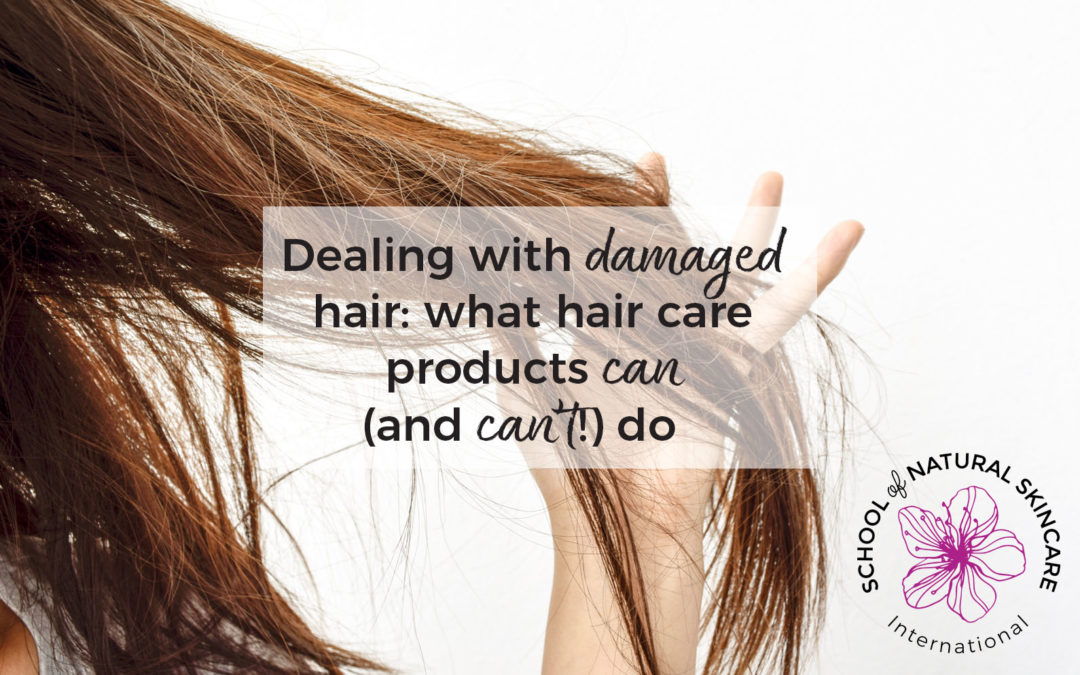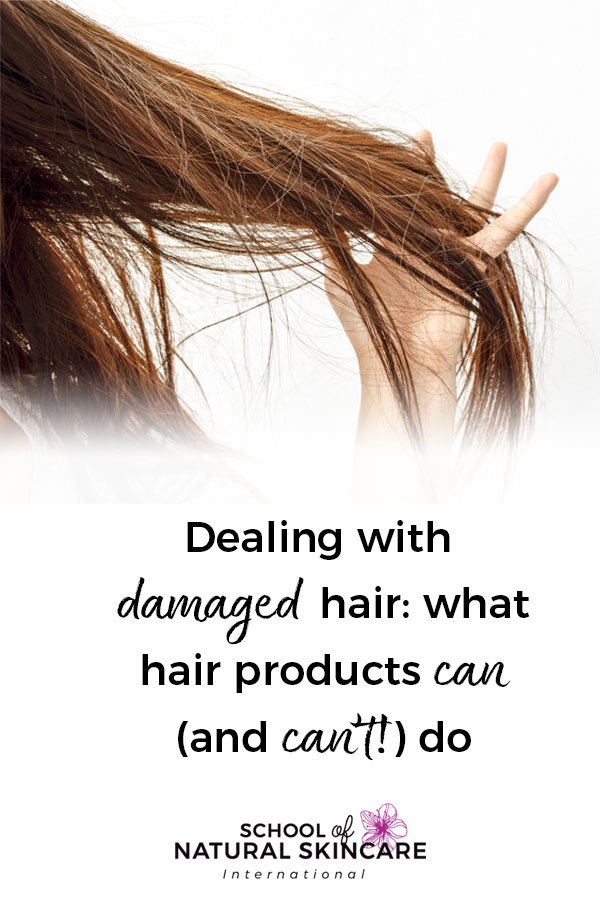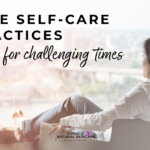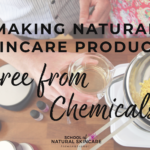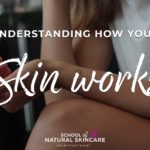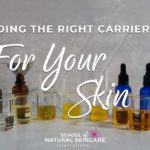Regardless of what certain advertisements for hair products want you to believe, your hair does not have the same regenerating mechanisms as your skin. Imagine cuts, bruises, scratches on the skin—they will heal over time. But if you break your hair, it will never grow back together. That’s because it contains no living cells that can regrow on the site of the damage. If it’s cut, it’s cut for good (as anyone with a tragic experience at the salon can tearfully confirm!)
Skin is alive, but hair is dead.
When it comes to treating the various types of damage that can occur to the skin and the hair, keeping this in mind will change the way you formulate your products. Really, it’s the guiding principle, and the difference between skin care and hair care.
But what does this mean when it comes to formulating your own products?
It all comes down to the promise of the product—what you, or your customers, expect the product will do, and what result you expect it to have. When selecting ingredients for the skin, we look for ones that will cleanse, nourish, hydrate, and heal. The ideal is finding the right formulation that helps the skin regenerate itself more effectively, from the inside out.
But for hair, that’s not really the case. If hair can’t be healed in the same way, if the cells don’t turn over and smooth out, then the ingredient that might work wonders on your dry or damaged skin may just weigh the hair strand down and provide little to no benefit.
Creating your own hair care products is very different to creating products for the skin for many reasons. We’ve covered most of the skin-related concerns before in a previous article, but we wanted to provide a more comprehensive look at what this really means when it comes to hair. If hair can’t really heal the way skin does, you might think, well what’s the point? What can you do, then?
That’s a great question.
If your hair is damaged, why bother?
Sure, there’s no product in the world that will fuse your chopped-off pixie cut back to your luscious mermaid waves, but that doesn’t mean there’s no point to proper hair care. After all, two of the most important reasons to get hair care products right are to stop ongoing damage, and to prevent further damage from happening.
Once hair is damaged, it’s often more prone to tangling, static, and more damage. This all creates a sort of domino effect that cascades until you’ve given up and gone for a buzz cut, just to stop the problem entirely.
You don’t have to let it get to that point, however! The keys to stopping and preventing damage are:
- Identify what’s causing the damage,
- Stop doing whatever that is,
- And use the right ingredients to protect the hair from there on out, no matter what state it’s in.
Even if it’s damaged, there are still ingredients that can be applied over the top of the hair shaft, making it softer, glossier, and smoother-feeling. You can change the appearance of your hair as you work to prevent further damage.
Common Sources of Hair Damage
There are a few sources of hair damage, and each one requires a slightly different approach to resolve.
Probably the most common source of damage to hair is physical damage. That can mean damage from brushing, manipulation, heat, and styling. Detangling too roughly, yanking or pulling, braiding hair tightly, all of these are physical sources of damage. You can avoid them by being aware of how you’re treating your hair, and styling more gently. Air-drying your hair every other day, instead of using a hair dryer, not wearing it back in a too-tight ponytail for hours every day, interspersing the times you have braids in with a protective style, or even changing your hairbrush and styling tools to ones more suited to your hair type can make a difference right away.
Another source of hair damage can be traced back to the health of your body, including your hydration, and balance of minerals, vitamins, healthy fats, and protein in your diet. The state of your hair is a bit of a canary in the coal mine, in a sense; if there’s a deficiency in your diet, your body will of course prioritize the more essential organs before ensuring that your hair has what it needs to be healthy, shiny, and thick. If it’s been dull, lank, and brittle for some time, maybe there’s something going on with your body, too. And health isn’t just limited to nutritional health, stress and disease can be factors as well. Are you taking good care of your whole self?
And of course, damage can happen as a result of products applied to the hair, and other external factors. This can include color treatments, perms and straighteners, and even the quality of your local water supply. Harsh sun, hard water or frequent trips to a chlorinated pool, or the humidity of your environment can all affect how your hair behaves, and can sometimes cause lasting and ongoing damage.
If you’re dealing with consistent hair problems or challenges, it might be a good idea to do some investigation into what might be causing them. Because of the nature of hair, the appearance of some internal, health-related problems might take some time to manifest, while external ones and product-related ones can appear almost overnight. Perhaps a ‘hair journal’ might help you trace your symptoms back to their causes.
Formulating your Hair Care Products with the Customer in Mind
Once you’ve targeted the source of the damage, and identified the needs of the hair, then you can begin formulating a product that will meet that need.
For the physical damage, as we mentioned before, changing the way you handle and style your hair can make a difference. The daily maintenance of your hair could include changing up your shampoo and conditioner, adding a heat-protecting spray for when you absolutely have to use a hair dryer, or adding a weekly treatment. (And these are all products you can learn to make in our Diploma in Natural Haircare Formulation course, by the way!)
In terms of physical damage, there are things you can do right away to help treat what’s happened and prevent more damage from occurring. A good conditioner contains the right oils, fats, and proteins to restore what’s been lost from the cuticle layer, and will help lay the cuticle down flat. This, in turn, will help minimize physical damage from combing, brushing, and styling, because the cuticles will be less likely to lift up further and break or tear. Also, using the right detangling ingredients (whether in a conditioner, or in a stand-alone product) will minimize friction and tangling.
In regards to damage caused by diet and internal factors, there’s only so much that topical treatments can do. Correcting the nutritional or hydration issues will hopefully correct the problem as the new hair begins to grow out. What your solution will be depends on what your body’s specific needs are. As you wait for the new hair to grow in, you can apply quality products to help add softness and shine to your already-damaged hair. A quality conditioner with oils (coconut oil especially) and proteins (keratin, hydrolyzed silk protein, hydrolysed plant protein) can help to restore fats and proteins missing from the cuticle.
Treating other external and environmental factors depends on what those factors are, what condition the damaged hair is in, and how you want to protect your hair going forward. You could formulate:
- A shampoo that helps combat the mineral deposits left by hard water
- A deep-conditioner for a swimmer’s chlorine-frazzled hair
- A detangling treatment for rough, color-treated hair
…or any number of custom-crafted solutions, depending on what the source of the damage is. All of these products can be made by formulating with the customer’s needs in mind. But what do you need to know about the actual formulation process to create successful products?
Bringing it All Together
If you want to make hair care products, knowing how to formulate skin care products is a great place to start. But while some of the same lab principles (mixing, emulsification, measuring pH) are used, the formulation is different in hair care. You also need a certain knowledge of hair anatomy and physiology in order to formulate safe and effective hair care products.
It’s important to only make and use hair care products that are specifically for the hair, and that contain ingredients that help the hair and scalp. If you want to make an effective shampoo, you need to select ingredients that cleanse the hair, close the cuticle, and balance the pH of the hair.
At first glance, lotions for the skin and conditioners for the hair might appear to be similar in nature, but they both serve a specific function. One helps the living skin heal and renew, and the other applies smoothing ingredients over the top of a dead hair shaft. If you want to make an effective conditioner you need to:
- Choose oils that contain beneficial fatty acids for the hair shaft
- Use the appropriate emulsifier
- Ensure that the amounts of conditioning ingredients in the formulation are high enough to be beneficial, but not too high to weigh the hair down
- Formulate a product that is suitable for the hair type; oily hair won’t use the same conditioner as dry hair
All of these things and more are covered in our Diploma in Natural Haircare Formulation coursework! You can learn how to formulate shampoos, conditioners, and hair treatments that customers come back to again and again, as well as learning more about the essential science behind effective hair care. Hop on over to our info page to learn more!
Get your free Natural Shampoo & Conditioner Recipe Book
Learn to make your own natural shampoos & conditioners with luxurious natural ingredients.
Download this fabulous book and discover recipes for:
- Cocoa Butter and Patchouli Solid Shampoo Bar
- Shea and Coconut Conditioner for Dry Hair
- Monoi Beauty Butter for Hair
- Vanilla and Benzoin Solid Conditioner Bar
- Gentle Aloe and Chamomile Liquid Shampoo for normal hair
Plus we’ll share with you:
- The primary function of shampoos and conditioners and how they work
- A handy video where Gail shows you the equipment that you’ll need
- A list of recommended suppliers in the UK, USA and Australia
- Tips on customizing for different hair types
- 7 powerful ingredients to personalize your haircare products
Enjoyed learning about what hair products can and can’t do? Save this image below on Pinterest so you can be sure to remember!

